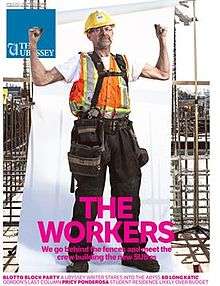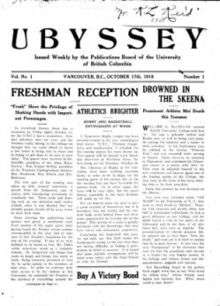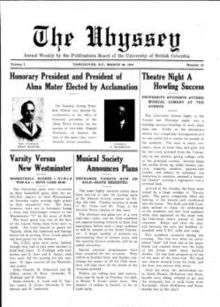The Ubyssey
The Ubyssey is the University of British Columbia's official, independent student-run paper and is published every Tuesday. Founded on October 18, 1918,[3] The Ubyssey is the most read student-run paper in Canada. Notable writers throughout its history include Pierre Berton, John Turner, Allan Fotheringham, Michael Valpy, Joe Schlesinger, Danny Stoffman, Stephen Scobie, Vaughn Palmer, Bruce Arthur, and Earle Birney.[4] Other notable alumni include cartoonist Arn Saba, journalist and author Katherine Monk, and photographers Jeff Wall and Richard Lam.
 | |
| Type | Weekly student newspaper |
|---|---|
| Format | Tabloid |
| Owner(s) | The Ubyssey Publications Society |
| President | Ali Zahedi |
| Editor | Alexandra Nguyen[1] |
| Founded | October 17, 1918[2] |
| Language | English |
| Headquarters | 6138 Student Union Blvd, Room 2208 Vancouver, British Columbia, Canada |
| Circulation | 6,000 (per issue) |
| Website | www.ubyssey.ca |
The Ubyssey is an independent publication funded by a $6.89 annual fee, from which students can opt out. The staff functions as a collective; current UBC students who have contributed to the paper and attend staff meetings are eligible to become staff members. The staff elects the full-time editors on an annual basis. The Ubyssey Publications Society board and president, who deal chiefly with management of the business affairs of the paper and do not play any editorial role, are elected by the general student body annually.
Publication
The Ubyssey is primarily web-based, but regular issues of the print edition appear once a week from September to April (except during exams or the Christmas break). Publishing during the summer term varies. In 2016 one print issue was produced per month, as well as two in August, but summer editions were not published in some years. The Ubyssey also maintains a web site with web-only news and video content.
The paper runs several recurring special issues including a guide for incoming students to on-campus life, and two satire issues.
The frequency of publication has varied historically. The paper was published four times a week in 1947, but this only lasted one year.[5] Until the 1980s, there were three issues per week, with Monday and Thursday issues being a standard, university news-oriented edition while The Ubyssey Magazine or "Page Friday" was published on Fridays.
History

The first issue of The Ubyssey was printed on October 17, 1918. Over the years the paper took stances supporting the demands for the building of UBC campus at Point Grey and the right of Japanese-Canadians to continue their studies after the bombing of Pearl Harbor. It also spoke out against fraternity hazing, which was banned on campus in 1924, and racist policies at some fraternities were exposed in the paper by Allan Fotheringham[6] in the 1950s.
In 1955 The Ubyssey was ranked the student publication with the most freedom and least faculty control in Canada. Rev. E. C. Pappert was then the faculty advisor with direct editorial control over the student newspaper at Assumption College in Windsor, which had been ranked bottom in that survey. Pappert's response was that “The Ubyssey is the vilest rag you can imagine and is the best argument for censorship that could be produced.”[6] The Ubyssey embraced Pappert's remarks and adopted “the vilest rag west of Blanca” as its unofficial slogan.

Irreverence and controversy have indeed been part of The Ubyssey's history. In 1959 the entire staff was fired by the Alma Mater Society (AMS) when a photo was published during the Easter period showing a UBC student crucified on a totem pole.[5] The last issue of the fall term satirizes campus issues and news stories. The spoof issue, published closest to April 1 spoofs another publication. Recent examples included The Grope and Flail, The Georgian Taint, Sports Inundated, Breitbarf, and a nude calendar spoofing a fundraising effort by the UBC men's rugby team. In 1974, a report, quoting the Pope, that Patty Hearst had given a speech to students in the Totem Park cafeteria prompted the arrival on campus of a KOMO-TV news team from Seattle which had taken it seriously.[6]
Shutdown by the AMS
Although The Ubyssey was at arm's length from the Alma Mater Society (AMS), it was still part of and published by the student union while one of its main roles was to report on the AMS's activities. At the same time, the AMS was forced to spend money to fight lawsuits on behalf of a media outlet from which it was continually fending off criticism.[5] This tension emerged in the early 1990s when disputes over editorial control led to the suspension of publication in the summer of 1993, when the AMS created a new "Publications Board" with power over the previously autonomous Ubyssey staff collective. The paper's staff eventually decided to work with the new board and resumed publication for the 1993–1994 school year, but its relationship with the AMS executive only deteriorated during this time with the paper vociferously criticizing the student union on a regular basis and attracting accusations of leftist bias.
The controversies came to a head when the annual spoof issue was published on March 30, 1994. ”The Ufeces” was a self-parody pushing the newspaper staff's own positions to extremes and satirizing their own conflicts with the union. It featured a satirical full-page ad suggesting that the AMS was self-serving, played favourites with clubs and did not care about students, and contained photographs of a female AMS executive in suggestive poses. This proved the final straw, and the AMS council passed a motion to give itself the sole power to choose the paper's editor-in-chief, who would then select all other editors. The AMS's hired editors, however, were unable to produce a paper as staff refused to cooperate. The AMS then changed the locks to the offices, shutting down The Ubyssey.
The fired editors, along with some UBC students, mobilized in response, campaigning to revive the paper. They formed the nonprofit Ubyssey Publications Society and placed a referendum question on the AMS elections ballot on reviving the paper as an independent entity, funded by a $5 fee from which students could opt out. Although there was concern about having enough votes cast to reach the quorum requirement, the referendum to revive The Ubyssey passed on January 24, 1995 with 67 per cent in favour.[5] The first issue of the newly independent Ubyssey was published on July 13, 1995. The Ubyssey also agreed to relocate its offices from the top floor to the basement of the Student Union Building once space became available, a move which was completed in 2001.
APEC to the 21st century
The Ubyssey played an important role in coverage of the protests which accompanied the holding of the 1997 APEC summit on UBC campus. Photo editor Richard Lam's photograph of RCMP officer Hugh Stewart pepper spraying protesters became iconic with Stewart becoming known as “Sergeant Pepper” and later being summoned to testify at a public inquiry into the police handling of the protests.[7]
Another major issue tackled by the paper in the 1990s was the ten-year exclusivity deal reached in 1995 between Coca-Cola, UBC, and the AMS allowing only Coca-Cola soft drinks to be sold on campus. The Ubyssey fought to force details of the confidential deal to be made public through a freedom of information request which was denied on the basis that it would harm the university's financial interests. The Ubyssey filed a lawsuit and the case eventually reached the Supreme Court of British Columbia which overturned the initial decision, with the deal finally being made public in May 2001.[8] In 2011, the student fee funding The Ubyssey was increased by referendum to $6 per student with an annual increase tied to inflation. The paper's reporting on a chant condoning non-consensual sex during Commerce Undergraduate Society (CUS) orientation activities in September 2013 led to the resignation of CUS executives, an investigation by UBC, and helped publicize similar incidents at other universities.[9]
With the completion of the AMS Nest in 2015, The Ubyssey offices moved into the new student union building. This agreement allows the Ubyssey to maintain an office in the AMS Nest in return for the AMS being allowed to run print ads throughout the school year.
References
- Alex Migdal (21 November 2019). "UBC's transparency questioned after proposal to ban recordings, live tweets at board of governors meetings". CBC News. Retrieved 2 March 2020.
- "The First Issue of The Ubyssey Is Published". University of British Columbia. Retrieved 2 March 2020.
- Davis, Chuck (1997-01-01). The greater Vancouver book: an urban encyclopaedia. Linkman Press. ISBN 978-1-896846-00-2.
- Earle Birney (1989). Spreading Time: Remarks on Canadian Writing and Writers, 1904-1949. Véhicule Press. p. 14. ISBN 9780919890954.
- Higgins, K. & McElroy, J. From the penthouse to the basement and everything in between: The Ubyssey from 1995 to 2008. The Ubyssey Publications Board, 2008.
- Hawthorn, T. The Ubyssey marks a checkered past. The Globe and Mail, 22 October 2008.
- CBC News. Sgt. Pepper defends spraying APEC protesters. Canadian Broadcasting Corporation, 3 December 1999.
- Jonathan Woodward. "Coke's deal refuels kerfuffle at UBC". The Globe and Mail, 1 September 2005.
- CBC News. "UBC investigates frosh students' pro-rape chant", Canadian Broadcasting Corporation, 9 September 2013.